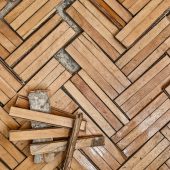Wood products are extremely sensitive to moisture and for this reason, you need to measure the percentage of water in the wood products that make them before use. Establishing the moisture content in wood products is possible through an instrument known as the moisture meter.
The information obtained from the moisture meter can help determine whether the material in question is ready for use, needs further inspection, or is unexpectedly dry or wet. When the moisture content is high, it can easily degrade the material over time.
Depending on the species, newly cut logs can have as much moisture content as 80% and above. By its nature, wood shrinks and can even twist or split as it dries. Assuming you are to use wood with a certain degree of moisture content unknowingly, with time it may shrink in dimensions and distort in shape thereby affecting the product or application you have put it into.
The Main Purpose of a Moisture Meter
Simply stated, a moisture meter gives you an approximate reading of the moisture content of wood. Through this reading, you can decide whether the wood is suitably dry and fit for the intended purpose.
The reading can also help you in project design planning which considers future changes in dimensions caused by relative humidity changes.
Wood to be used in making floors, furniture, and general construction work, ought to be in an ideal state of equilibrium moisture content (EMC). This equilibrium means that the wood balances with the surrounding environment’s relative humidity. When this balance is attained, the wood neither gains nor loses in moisture content.
Types of Moisture Meters
In the wood working industry, there are two main types of moisture meters: the pin type and pinless meters. Both meters help in measuring the moisture effect on an electromagnetic field (pinless) or an electric current (pin type) to determine the degree of moisture content in the wood.
1. Pinless Meters
These are also referred to as electromagnetic field meters. The advantage with a pinless moisture meter is that it can scan an entire board quickly without piercing the wood. They work by emitting an electrical wave through a sensor which is pressed against the wood. This results in an electromagnetic field that measures the size of the sensor and which extends to a depth of between 0.75 and 10 inches. The behavior of the electromagnetic field changes depending on the moisture content of the wood being inspected.
Electromagnetic field meters measure the wood’s capacity to store energy also known as capacitance; the resistance of the wood to the electromagnetic field also referred to as impedance and the amount of power absorbed from the electromagnetic field by the wood which is known as power loss. This electrical information is then translated to ascertain the percentage of moisture content present. The beauty with a pinless meter is its portability. This comes in handy when buying wood because you can easily carry it to the lumberyard and test the wood right there.
2. The Pin Type
These are also called resistance meters. They can take readings in wood irrespective of its size, shape, or degree of roughness. All that you need, is to push the pins into the wood in different spots covering the dimension you want to capture. A direct current is then initiated which travels from one pin to the other. This process helps in measuring the resistance in the section covered by the pins and translates this into wood moisture content.
Wood Species and Temperature Correction
The readings given by the above meters are affected by the wood density and temperature. By default, moisture meters are set to read the moisture content of Douglas fir at temperatures of about 68 degrees Fahrenheit. When taking the readings, you will therefore be required to adjust.
Depending on the brand of moisture meter you are using, it may even have built-in species correction and temperature correction. You don’t have to struggle taking the readings, all you do is to set the meter for the desired species and it will adjust automatically to capture the right readings. This is especially important when dealing with a lot of wood from varieties of species.
Compared to pinless meters, pin meters are more sensitive to variations in temperature. Because of this, pin meters come with temperature correction charts. On the other hand, pinless meters are sensitive to density variations of species. When taking measurements of different woods, you should first set the specific gravity to correspond to that of the species.
- Read also: Best Carbon Monoxide Detectors
What to Look for When Buying a Moisture Meter
The first question you are likely to ask yourself when shopping for a moisture meter is whether to buy a pin type or pinless meter. The best way to handle this question is to determine your needs and then look at the unique features of each meter. The following are some of the considerations you should make when telling the meters apart.
1. Pin Length
There is a general rule which states that the average moisture content depth of a wood board is equal to a quarter or a fifth of the thickness of the board. For instance, if you have a board measuring 1.5 inches in thickness, you can get a reading using pins measuring 0.3125 inches. However, this works best if the wood has a smooth moisture gradient where the core is wetter than the surface.
2. Minimum Sample Size
The size of the sensor plate in a pinless meter dictates the minimum sample size. The whole plate must touch the wood being tested. This means if you are having a board measuring 1.5 inches wide, the best pinless meter is that with a sensor pad measuring 2 inches x 2 inches.
3. The Range of Moisture Content
For accuracy in your readings, a range of 7 to 20% of moisture content is recommended. Purchasing meters with a moisture content testing range beyond 20% may result into erroneous readings. That said, if you dry your own wood and you would want to know the degree of wetness before starting the drying process, you can go for meters with higher readings.
4. Displays
There are 4 main types of meter displays: light emitting diode (LED), liquid crystal display (LCD), analogue, and digital LED. The preferred displays are digital, LED, and LCD. Look at the screen resolution because it determines the clarity and accuracy of the reading.
Some of the main moisture meter brands include Tramex, Extech, Flir, and Protimeter.
The Best Moisture Meter Reviews
1. Extech MO257 Pinless Moisture Meter
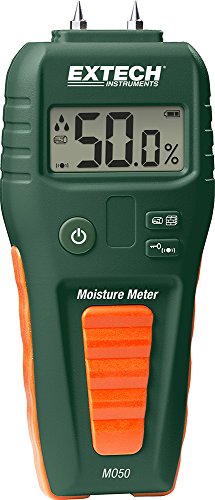
The Extech MO257 meter measures the moisture content in wood as well as other building materials without damaging the surface. Its high frequency sensing technology allows it to take accurate non-invasive readings.
You can set moisture content points and set programmable alarms which go off when the moisture exceeds the set limits. When you buy Extech MO257, it is shipped fully calibrated and tested to give you years of reliable service.
It has a backlit LCD display. Its operating temperature is 4 to 43 degrees Celsius, a moisture range starting from 0.20 to 100.0 and a measurement depth of 20 to 40 mm.
2. Extech MO50 Compact Pin Moisture Meter
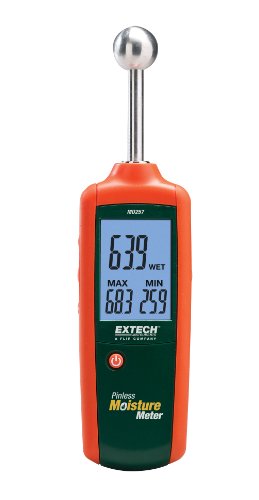
This is an easy to operate moisture meter that gives audible tones, measurement digits, and moisture drop icons to show the level of moisture content. This meter is great for applications where detection of moisture level under carpets and floors is critical. It can also be used in building restoration projects.
It has an LCD display showing the moisture level in wood and building materials. It also comes with an audible tone which beeps faster as the moisture content rises. With a resolution of 0.1%, an accuracy of ±3.0%, and a measurement range from 5% to 50%, the Extech MO50 is one of the most dependable moisture meters.
3. Tramex SMP Interference Free Measurements Fibreglass
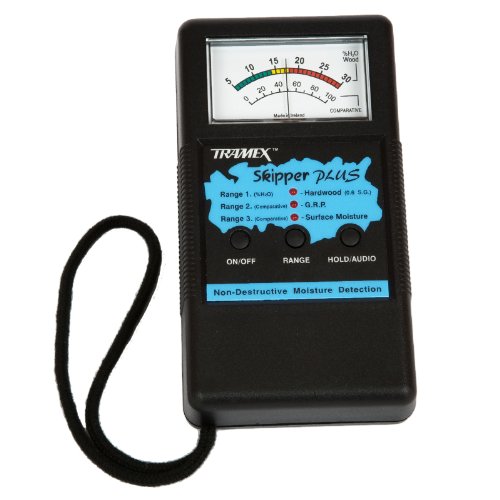
This is a non-destructive pinless meter that gives you a safe and complete method for detecting excess moisture in wooden boats. It has 3 moisture detection ranges for hardwood, GRP, and surface moisture.
Its range of readings are 5% to 30% for hardwood and on the comparative scale for GRP its readings range from 0 to 100. It helps to confirm whether wooden boards are dry enough for vanishing or painting and plays a key role as well in bulkhead and trace deck leaks. It is battery operated and has soft rubber transmitting and receiving electrodes which do not scratch the surface.
4. Protimeter Digital Moisture Meter BLD5702
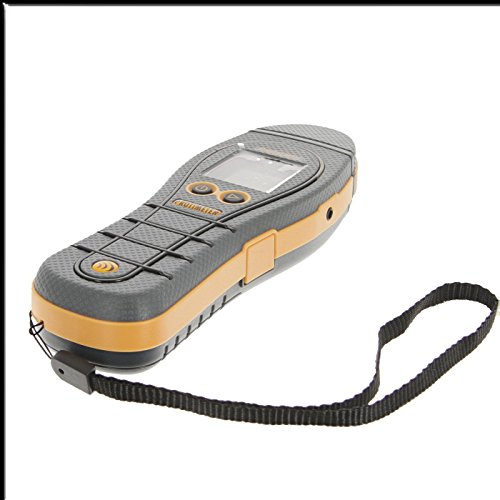
This is a must-have instrument for contractors, homebuilders, surveyors, and architects to help them in assessing the moisture level during new builds and when doing refurbishing. It has a beautiful color LED display to show the results.
Since it is calibrated for wood, it shows the actual moisture content percentage when used on wood. If you use it on other materials, it displays the wood moisture equivalent. The size of the pin is up to a half inch and it has green display for dry, yellow display for risk, and red for wet. Its total weight including batteries is 225 grams meaning you can carry it around.
5. MR176 Imaging Moisture Infrared Measurement
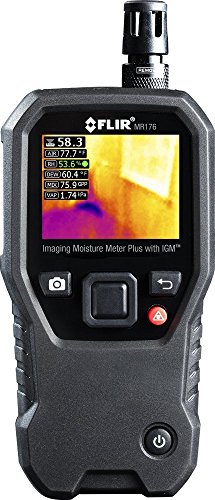
This is an all-in-one moisture meter that comes with a built-in thermal camera which shows the exact point to measure moisture. This is made possible by the infrared guided measurement (IGM) technology which quickly scans and spots where you should take the moisture measurements.
Unlike other meters which are either pinless or pin type, this meter incorporates both which means you can take intrusive or non-intrusive measurements. Thanks to its field replaceable temperature sensor and relative humidity sensor, you can easily capture the environmental condition reading.
The thermal image resolution is 4800 pixels, the wet area detection is 19.7 square inches and the moisture measurement for the pin type is 7% to 30% with a comparative scale of 30% to 100%. The basic accuracy is ±1.5% moisture content.
What to purchase from the above is determined by your personal preferences and the kind of task that is ahead of you. Remember each brand also has its own strengths which you should compare across before making the buy decision.

